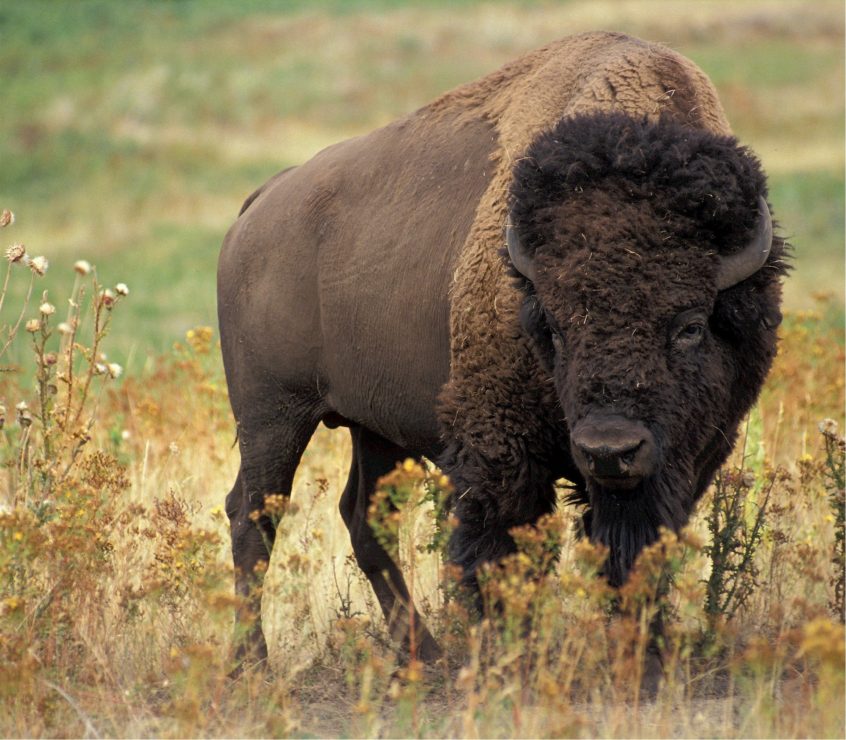- Scientific name: Bison bison bison
- SARA Status: Not on Schedule 1 – on consideration for status update
- COSEWIC Status: Threatened
- COSEWIC Range: British Columbia, Alberta, Saskatchewan
Bison once roamed the Great Plains in vast herds that stretched miles long, and yet, years later, they were on the brink of extinction. Today, bison represent strength and resilience and are an important symbol of the prairies. However, they are yet to be listed federally under Species at Risk Act as ‘threatened’, despite COSEWIC’s recommendation to do so.



Before the arrival of European colonizers, it is estimated that there was somewhere between 30-70 million bison roaming the plains. Their range stretched from central Alberta and Saskatchewan, all the way to northern Mexico.
With millions of hooves stomping across the land over such long distances, bison shaped the ecology of the prairies, and some of the traditional routes they travelled can even be viewed from the sky.
Being the largest mammal in North America, bison provided Indigenous people all over the continent with meat. Other parts of the bison were crafted into clothing, shelter, and tools. They were an undoubtedly integral part of Indigenous peoples’ lives.
This all changed however, when the Europeans arrived in the 1800s. Bison were slaughtered by the millions for commercial uses. Beyond these financial benefits, it has been argued that the mass systemic harvesting of bison was also used as a tool of oppression. For many groups, the destruction of the bison dramatically changed their life.
Not only did the collapse of the bison threaten the lives of Indigenous people, but it also threatened the health of the prairie ecosystem. Native grasslands evolved with large grazers that made their way through the land, grazing the grass and turning up the soil while fertilizing it with their urine and feces.
This disturbance rejuvenated the grasses and promoted diversity while allowing many other grassland species such as birds and rodents to thrive, attracting species from all levels of the food chain.
Close to reaching extinction at the end of the 19th century, bison dwindled to eight individuals in Canada and 85 in North America. This shocking number led to the onset of breeding and reintroduction programs.
Although today bison only occupy less than 0.5% of their original range, there are a few stable populations in Canada, which have even increased 36% since their last assessment in 2004. Wild bison populations only exist within British Columbia and Saskatchewan, while semi-wild and captive herds are managed in Alberta, Saskatchewan, and Manitoba.
Threats: Though much of the herds in Canada are managed and protected, they still face a number of threats. Of course, being the largest mammal in North America, these species require large spaces to roam in. The land they are now confined to limits how much their population is able to grow.
Moreover, the existing populations are completely isolated from each other, often with structures such as fences. Bison will never be able to exist in numbers they once did.
Bison populations that are nearby cattle operations are at risk of being exposed to diseases that are carried by cattle. The genetic integrity of bison is an additional threat that poses challenges to the species. Hybridization between Plains and Wood bison, as well as bison that have escaped from fields, threatens the genetic diversity of Plains bison and has been a big problem in past re-introductions.
The Sturgeon River Plains Bison herd found North of Prince Albert are experiencing many threats. Over hunting and anthrax disease are contributing to their imminent decline. CPAWS SK is making efforts to bring groups together to effectively manage the herd: Sturgeon River Plains Bison.
What’s being done: The recovery of bison to stable populations did not come without issues. Risks such as disease and genetic pollution threatened the whole process, but luckily, enough survived to establish populations.
While provincial protection varies from each province, herds that occur within National Parks are protected under the Canada National Parks Act. The wild population in British Columbia is protected against unregulated hunting, and in Saskatchewan, a permit is required for non-Aboriginal hunters.
The Federal Government has yet to officially declare Plains bison as “threatened” under the Species at Risk Act (SARA)—despite the Committee on the Status of Endangered Wildlife in Canada’s (COSEWIC) recommendation to do so in 2004 and again in 2013.
CPAWS has been actively campaigning to see Plains Bison officially listed so that more formal protection and management plans can be created.
Resources:

